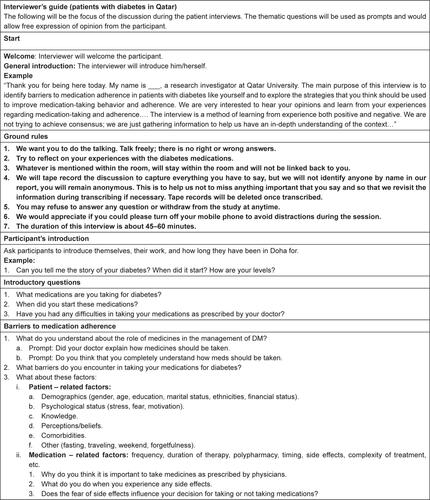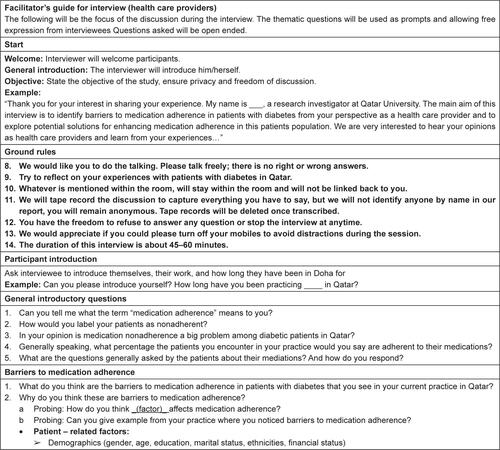Abstract
Purpose
To develop an in-depth understanding of the barriers to medication adherence among patients with uncontrolled diabetes attending primary health care (PHC) centers in Qatar by exploring and integrating patients’ and health care providers’ perspectives.
Participants and methods
A descriptive qualitative methodology was used in this study. A trained researcher conducted semi-structured face-to-face interviews at two PHC centers. Patients with uncontrolled diabetes (with varied sociodemographic characteristics) and their respective health care providers (physicians, pharmacists, nurses, dieticians, and others) were purposively selected from the two PHC centers. All interviews were audio recorded, transcribed verbatim, and analyzed using thematic content analysis.
Results
Thirty interviews (14 patients and 16 health care providers) were conducted. A number of barriers to medication adherence were identified and classified broadly under three main themes: 1) patient-related factors, which included patients’ individual characteristics and patients’ perception, attitude, and behavior; 2) patient–provider factors, which included communication and having multiple health care providers caring for the patient; and 3) societal and environmental factors, which included social pressure and traveling to visit friends and relatives.
Conclusion
Patients with uncontrolled diabetes face multiple barriers to medication adherence. Similar themes emerged from both patients and their care providers. This research highlights the need for concerted multidimensional efforts and series of interventions to overcome these barriers. One vital intervention is expanding the scope of pharmacists’ role within the PHC centers through providing medication reconciliation, patient-tailored medication counseling, and medicines use review, which may improve treatment outcomes among patients with diabetes.
Supplementary materials
Acknowledgments
The authors would like to thank Qatar University for providing grant and the Primary Health care Corporation for providing the resources needed to conduct this project including the ethics approval. The authors thank all the pharmacists who were very supportive in the conduct of the study in the health centers. Finally, thanks to all the participants who contributed to enriching our knowledge about their experience.
This work was supported by Qatar University Student Grant (QUST-CPH-SPR 15/16-19). The funding source was not involved in the study design, data collection, analysis and interpretation of data, the writing of the report, and the decision to submit the manuscript for publication.
Disclosure
The authors report no conflicts of interest in this work.




